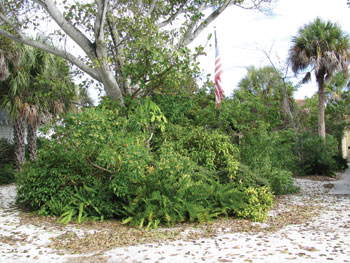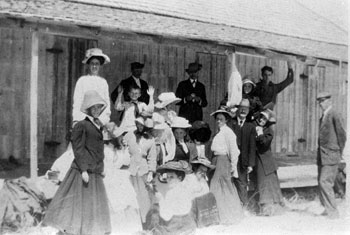Plants chilled, not killed

SUN PHOTO/CINDY LANE Native landscaping planted
between
Anna Maria City Hall and the Island Playhouse
lost some
leaves during the prolonged cold snap
earlier this month,
but is expected to survive.
Dead fish washing up onto the beaches is the most obvious evidence of the prolonged cold snap earlier this month, but plants may fare better.
That is, if people leave them alone, plant experts say.
Don’t trim cold-damaged plants until at least Valentine’s Day, say the master gardeners at the Manatee County Extension Service. That’s because trimming makes the plants produce new growth, which could be killed by frost until around the middle of February, the last time frost is predicted in our area, according to the National Weather Service. A plant whose new growth is hit by freezing temperatures after being cold-stressed a month earlier might not survive.
Don’t dig up brown plants just because they’re brown. Many plants naturally turn brown in winter and revive in spring, and if you don’t know what you’re digging up, you could ruin perfectly good foliage.
Many species that don’t normally turn brown have done so after nearly two weeks of unusually cold temperatures, but give them a chance, says Mike Miller of perfectisland.us, who landscaped Anna Maria City Hall with native plants.
“Don’t do anything but watch them turn brown and watch the leaves fall off,” he said, adding that most will revive. “The key thing to expect is no matter what you have, the likelihood that it’s dead is very, very low.”
The chances that a plant will drop its leaves after a cold snap depends on how much farther south the plant actually belongs, Miller said. For example, a few days after the cold snap, sea grapes on the Island defoliated almost overnight. The native plant thrives farther south, and Tampa Bay is practically its northernmost boundary, he said.
Still, it will survive, if left alone to recover.
The same goes for chopping off brown palm fronds – don’t – as they protect the green fronds growing underneath. Palms damaged by cold should not be pruned until the new fronds fully emerge. State landscaping guidelines recommend that palm trees should not be trimmed back to the popular look of a half-dozen fronds protruding nearly vertically from the top, because the severe cut, and the shaving of the brown boots below that often goes with it, makes the tree vulnerable to pests and disease. Generally, brown palm fronds should not be trimmed until new fronds appear, as the brown fronds protect the new growth.
Do not pull out brown sea oats from the beach – they will recover, and are federally protected, Miller said, adding that other beach plants including purple-flowered railroad vines, which normally lose their leaves in winter, and yellow beach sunflowers also will bounce back.
If another cold spell is predicted, water the ground around your plants – not the plants themselves – before it arrives, Miller recommended, as dehydration and cold are a deadly combination.
As for trimming guidelines in normal weather, an Island gardener’s rule of thumb should be “Don’t trim anything that’s not in your way,” Miller said.


